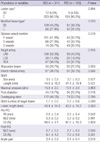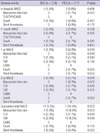1. Morice MC, Serruys PW, Sousa JE, Fajadet J, Ban Hayashi E, Perin M, Colombo A, Schuler G, Barragan P, Guagliumi G, Molnàr F, Falotico R. RAVEL Study Group. Randomized Study with the Sirolimus-Coated Bx Velocity Balloon-Expandable Stent in the Treatment of Patients of Patients with de Novo Native Coronary Artery Lesions. A randomized comparison of a sirolimus-eluting stent with a standard stent for coronary revascularization. N Engl J Med. 2002. 346:1773–1780.
2. Degertekin M, Serruys PW, Foley DP, Tanabe K, Regar E, Vos J, Smits PC, van der Giessen WJ, van den Brand M, de Feyter P, Popma JJ. Persistent inhibition of neointimal hyperplasia after sirolimus-eluting stent implantation: long-term (up to 2 years) clinical, angiographic, and intravascular ultrasound follow-up. Circulation. 2002. 106:1610–1613.
3. Kobayashi Y, De Gregorio J, Kobayashi N, Akiyama T, Reimers B, Finci L, Di Mario C, Colombo A. Stented segment length as an independent predictor of restenosis. J Am Coll Cardiol. 1999. 34:651–659.
4. Foley DP, Pieper M, Wijns W, Suryapranata H, Grollier G, Legrand V, de Scheerder I, Hanet C, Puel J, Mudra H, Bonnier HJ, Colombo A, Thomas M, Probst P, Morice M, Kleijne J, Serruys PW. MAGIC 5L Investigators. The influence of stent length on clinical and angiographic outcome in patients undergoing elective stenting for native coronary artery lesions: final results of the Magic 5L Study. Eur Heart J. 2001. 22:1585–1593.
5. de Feyter PJ, Kay P, Disco C, Serruys PW. Reference chart derived from post-stent-implantation intravascular ultrasound predictors of 6-month expected restenosis on quantitative coronary angiography. Circulation. 1999. 100:1777–1783.
6. Cutlip DE, Windecker S, Mehran R, Boam A, Cohen DJ, van Es GA, Steg PG, Morel MA, Mauri L, Vranckx P, McFadden E, Lansky A, Hamon M, Krucoff MW, Serruys PW. Academic Research Consortium. Clinical end points in coronary stent trials: a case for standardized definitions. Circulation. 2007. 115:2344–2351.
7. Cook S, Wenaweser P, Togni M, Billinger M, Morger C, Seiler C, Vogel R, Hess O, Meier B, Windecker S. Incomplete stent apposition and very late stent thrombosis after drug-eluting stent implantation. Circulation. 2007. 115:2426–2434.
8. Ellis SG, Vandormael MG, Cowley MJ, DiSciascio G, Deligonul U, Topol EJ, Bulle TM. Multivessel Angioplasty Prognosis Study Group. Coronary morphologic and clinical determinants of procedural outcome with angioplasty for multivessel coronary disease. Implications for patient selection. Circulation. 1990. 82:1193–1202.
9. Wessely R, Kastrati A, Schömig A. Late restenosis in patients receiving a polymer-coated sirolimus-eluting stent. Ann Intern Med. 2005. 143:392–394.
10. Windecker S, Remondino A, Eberli FR, Juni P, Räber L, Wenaweser P, Togni M, Billinger M, Tuller D, Seiler C, Roffi M, Corti R, Sütsch G, Maier W, Lüscher T, Hess OM, Egger M, Meier B. Sirolimus-eluting and paclitaxel-eluting stents for coronary revascularization. N Engl J Med. 2005. 353:653–662.
11. Lee CW, Park KH, Kim YH, Hong MK, Kim JJ, Park SW, Park SJ. Clinical and angiographic outcomes after placement of multiple overlapping drug-eluting stents in diffuse coronary lesions. Am J Cardiol. 2006. 98:918–922.
12. Kim YH, Park SW, Lee SW, Park DW, Yun SC, Lee CW, Hong MK, Kim HS, Ko JK, Park JH, Lee JH, Choi SW, Seong IW, Cho YH, Lee NH, Kim JH, Chun KJ, Park SJ. Long-DES-II Study Investigators. Sirolimus-eluting stent versus paclitaxel-eluting stent for patients with long coronary artery disease. Circulation. 2006. 114:2148–2153.
13. Chu WW, Kuchulakanti PK, Torguson R, Wang B, Clavijo LC, Suddath WO, Pichard AD, Satler LF, Kent KM, Waksman R. Impact of overlapping drug-eluting stents in patients undergoing percutaneous coronary intervention. Catheter Cardiovasc Interv. 2006. 67:595–599.
14. Ruchin PE, Trabattoni D, Fabbiocchi F, Montorsi P, Lualdi A, Ravagnani P, Grancini L, Galli S, Teruzzi G, Calligaris G, De Martini S, Bartorelli AL. Use of multiple overlapping sirolimus-eluting stents for treatment of long coronary artery lesions: results from a single-center registry in 318 consecutive patients. Int J Cardiol. 2009. 134:231–237.








 PDF
PDF ePub
ePub Citation
Citation Print
Print






 XML Download
XML Download